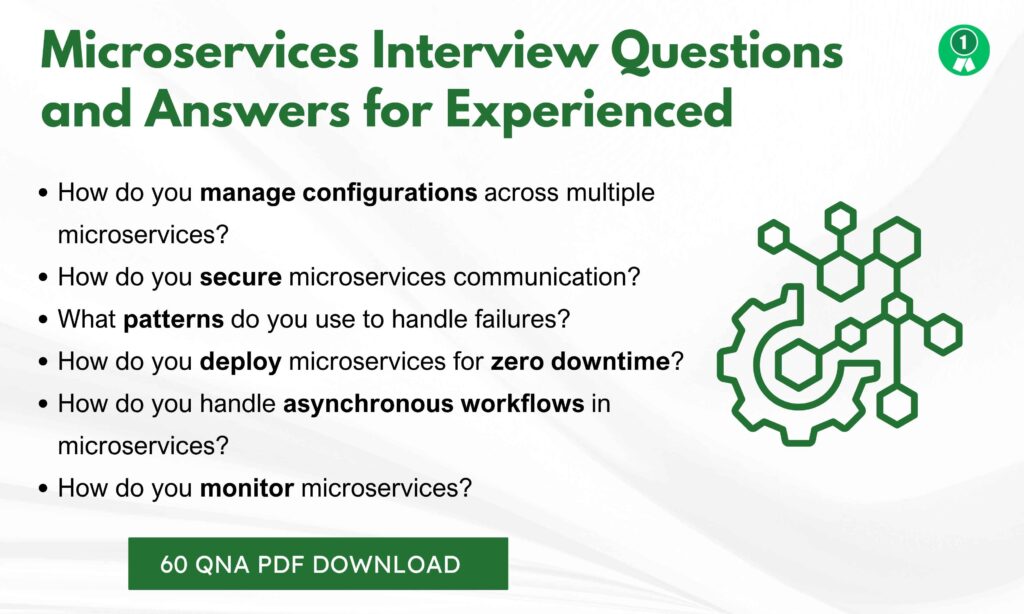Experienced microservices professionals are expected to design fault-tolerant, scalable, and secure microservice-based systems that can handle high traffic, real-time data processing, and complex business logic. With tools like Spring Boot (Java) or .NET Core (C#), they build distributed applications that are cloud-native, container-ready, and easily maintainable.
For experienced candidates, microservices interviews go beyond definitions and dive deep into practical scenarios. You’ll be asked about designing APIs for microservices, choosing between synchronous vs asynchronous messaging, implementing circuit breakers, API gateways, service discovery patterns, CI/CD pipelines, and performance tuning.
Here we have added Top Microservices Interview Questions for Experienced Professionals, focusing on advanced topics, design decisions, and problem-solving scenarios.
Freshers can check another guide here: Top 100 Microservices Interview Questions and Answers PDF
Table of Contents
Microservices Interview Questions and Answers for 3 Years Experienced
Que 1. How do you handle service-to-service communication in microservices?
Answer:
Service-to-service communication can be handled using:
- Synchronous communication: RESTful APIs with tools like Feign Client or gRPC for lightweight communication.
- Asynchronous communication: Message brokers like RabbitMQ, Kafka, or ActiveMQ to decouple services.
- Always implement retries, timeouts, and circuit breakers to avoid cascading failures.
Que 2. How do you ensure data consistency in microservices?
Answer:
- Implement the Saga pattern for distributed transactions with compensating actions.
- Use event sourcing to maintain the state through event history.
- Design APIs to be idempotent to handle retries without duplicating operations.
Que 3. How do you manage configurations across multiple microservices?
Answer:
- Use a centralized configuration server like Spring Cloud Config or HashiCorp Consul.
- Store sensitive values securely in Vault or AWS Secrets Manager.
- Refresh configurations dynamically with tools like Spring Cloud Bus to avoid restarting services.
Que 4. How do you secure microservices communication?
Answer:
- Implement OAuth2 with JWT tokens for authentication and authorization.
- Use TLS/SSL for encrypting communication between services.
- Add an API Gateway to centralize security and reduce direct exposure of microservices.
Que 5. How do you implement service discovery in microservices?
Answer:
- Use a registry like Eureka, Consul, or Kubernetes Service Discovery.
- Each service registers itself and queries the registry to find other services dynamically.
- Combine with client-side load balancing tools like Ribbon or server-side load balancers.
Que 6. What patterns do you use to handle failures?
Answer:
- Implement circuit breakers using Resilience4j or Hystrix to prevent cascading failures.
- Use bulkheads to isolate resource usage per service.
- Apply fallback strategies for degraded functionality during downtime.
Que 7. How do you implement centralized logging?
Answer:
- Use ELK Stack (Elasticsearch, Logstash, Kibana) or Splunk for log aggregation and visualization.
- Include trace IDs and span IDs in logs using frameworks like Spring Cloud Sleuth.
- Forward logs asynchronously to reduce overhead on services.
Que 8. How do you perform API versioning?
Answer:
- Include version numbers in URLs (e.g., /api/v1/resource) or headers.
- Support multiple versions simultaneously to allow clients time to upgrade.
- Deprecate older versions gracefully and communicate changes clearly.
Que 9. How do you test microservices effectively?
Answer:
- Write unit tests using JUnit or similar frameworks.
- Perform integration tests for service dependencies.
- Use contract testing tools like Pact to verify compatibility between services.
- Run end-to-end tests using Postman or RestAssured.
Que 10. How do you deploy microservices for zero downtime?
Answer:
- Use rolling updates or blue-green deployments in Kubernetes or other orchestrators.
- Keep API and database changes backward compatible.
- Automate database migrations using tools like Flyway or Liquibase.
Que 11. How do you implement an API Gateway and why is it needed?
Answer:
- Use Spring Cloud Gateway, Zuul, or Kong to route requests to backend services.
- API Gateways handle cross-cutting concerns like authentication, rate limiting, and logging.
- They also simplify client interactions by aggregating responses from multiple services.
Que 12. How do you monitor microservices?
Answer:
- Use Spring Boot Actuator for health and metrics endpoints.
- Collect metrics using Prometheus and visualize in Grafana.
- Implement distributed tracing using Jaeger or Zipkin.
Que 13. How do you handle asynchronous workflows in microservices?
Answer:
- Use message brokers like Kafka or RabbitMQ to decouple workflows.
- Implement dead-letter queues for failed messages.
- Use frameworks like Spring Cloud Stream to simplify event-driven communication.
Que 14. How do you design a database-per-service architecture?
Answer:
- Each microservice should own its database schema to maintain loose coupling.
- Synchronize data across services using events rather than direct queries.
- Implement read models or caches for cross-service queries.
Que 15. How do you containerize microservices?
Answer:
- Create a Dockerfile for each service:
FROM openjdk:17-jdk-alpine
COPY target/app.jar app.jar
ENTRYPOINT ["java", "-jar", "/app.jar"]- Push Docker images to a registry and deploy them using Kubernetes or Docker Compose.
Que 16. What strategies can you use to make microservices communication more resilient?
Answer: Microservices communication can fail due to network issues or service downtime, so you must design for resilience.
| Strategy | Description |
|---|---|
| Circuit Breakers | Stop calling a failing service temporarily to prevent cascading failures (e.g., Resilience4j) |
| Retries with Backoff | Retry failed requests after increasing time intervals |
| Bulkheads | Isolate resources so a failure in one service does not affect others |
| Timeouts | Set timeouts for external calls to avoid waiting indefinitely |
Example using Resilience4j’s Circuit Breaker:
@CircuitBreaker(name = "paymentService", fallbackMethod = "fallbackPayment")
public PaymentResponse callPaymentService() {
return restTemplate.getForObject("/payment", PaymentResponse.class);
}
public PaymentResponse fallbackPayment(Throwable t) {
return new PaymentResponse("Service unavailable");
}
These patterns help maintain system stability when services fail or slow down.
Que 17. How do you implement caching in microservices?
Answer:
- Use Redis or Memcached for distributed caching.
- Apply cache-aside or write-through patterns depending on use cases.
- Invalidate cache carefully to avoid stale data.
Que 18. How do you ensure scalability in microservices?
Answer:
- Design stateless services that can scale horizontally.
- Use asynchronous communication to reduce coupling.
- Employ container orchestration tools like Kubernetes to handle auto-scaling.
Que 19. How do you handle service dependencies?
Answer:
- Minimize dependencies by maintaining clear service boundaries.
- Use consumer-driven contracts to manage expectations between services.
- Apply retries and backoff strategies for dependent services.
Que 20. How do you design microservices for high availability?
Answer:
- Deploy services across multiple availability zones or data centers.
- Use load balancers to distribute traffic and failover mechanisms.
- Continuously monitor service health and use self-healing techniques like container restarts.

Also Check: Spring Boot Interview Questions for Experienced Professional
Microservices Interview Questions for 5 Years Experienced
Que 21. How do you design microservices to handle distributed transactions?
Answer:
- Implement the Saga pattern with orchestrators (like Camunda) or choreography using events.
- Use compensating transactions to rollback partial failures.
- Ensure idempotency in APIs to handle retries gracefully.
Que 22. How do you deal with eventual consistency in microservices?
Answer:
- Adopt event-driven communication to propagate changes asynchronously.
- Use reliable message brokers (Kafka, RabbitMQ) with exactly-once or at-least-once delivery.
- Provide clients with mechanisms like query retries or notifications to handle eventual consistency.
Que 23. How do you scale microservices that have heavy workloads?
Answer:
- Design services stateless so they can be scaled horizontally.
- Offload time-consuming tasks to background workers using queues.
- Apply auto-scaling policies in Kubernetes or cloud platforms based on CPU/memory or custom metrics.
Que 24. How do you manage schema evolution in microservices databases?
Answer:
- Use tools like Flyway or Liquibase for controlled migrations.
- Ensure backward compatibility by using additive schema changes before destructive ones.
- Maintain versioned APIs and database schemas during deployments.
Que 25. How do you secure inter-service communication beyond TLS?
Answer:
- Use mutual TLS (mTLS) to validate both client and server certificates.
- Adopt service meshes like Istio or Linkerd to enforce authentication and encryption.
- Implement token-based authentication (JWT or OAuth2) for additional security.
Que 26. How do you handle distributed logging and tracing in microservices?
Answer: In microservices, requests flow through multiple services, so centralized logging and tracing are essential.
| Tool/Pattern | Purpose |
|---|---|
| Sleuth + Zipkin | Adds trace IDs and span IDs to logs and visualizes request flow |
| ELK Stack (Elasticsearch, Logstash, Kibana) | Collects, processes, and visualizes centralized logs |
| OpenTelemetry | Standardized observability for traces, metrics, and logs |
Example with Spring Cloud Sleuth:
- Sleuth automatically adds trace and span IDs to every request log.
- Zipkin collects and displays trace data, making it easier to identify bottlenecks and failures.
Centralized tracing ensures faster debugging and better understanding of request flow in distributed systems.
Que 27. How do you handle cross-cutting concerns in microservices?
Answer:
- Centralize cross-cutting concerns such as logging, metrics, and authentication using API Gateways.
- Use frameworks like Spring AOP for consistent handling across services.
- Service meshes can be leveraged for observability and traffic management.
Que 28. How do you implement blue-green and canary deployments?
Answer:
- Blue-green: Maintain two environments (blue and green), switch traffic between them after validation.
- Canary: Gradually release changes to a small subset of users before full rollout.
- Use Kubernetes deployment strategies or tools like Argo Rollouts to automate.
Que 29. How do you manage dependencies between services without tight coupling?
Answer:
- Adopt consumer-driven contracts to define clear expectations.
- Use event-based communication instead of synchronous requests where possible.
- Avoid sharing databases directly between services.
Que 30. How do you implement observability in a large-scale microservices environment?
Answer:
- Instrument services with OpenTelemetry for distributed tracing.
- Aggregate logs using ELK or Splunk and correlate with metrics from Prometheus.
- Set up alerts and dashboards with Grafana for proactive monitoring.
Que 31. How do you handle large message payloads in asynchronous communication?
Answer:
- Store large payloads in external storage (S3, GCS) and send references via messages.
- Compress messages before sending them through brokers.
- Implement chunking and reassembly mechanisms for very large data sets.
Que 32. How do you achieve strong security and compliance in microservices?
Answer:
- Enforce least privilege for each service and secure secrets with Vault or AWS Secrets Manager.
- Perform regular vulnerability scans and dependency checks.
- Apply security patches automatically using CI/CD pipelines.
Que 33. How do you handle stateful services in microservices architecture?
Answer:
- Use persistent external storage solutions like databases or distributed caches.
- If state must be in memory, use sticky sessions but only as a temporary solution.
- Consider Kubernetes StatefulSets for managing stateful services.
Que 34. How do you mitigate cascading failures in microservices?
Answer:
- Implement circuit breakers (Resilience4j, Hystrix) to isolate failures.
- Apply bulkhead patterns to restrict resource sharing between services.
- Use backpressure mechanisms to handle overload gracefully.
Que 35. How do you handle data duplication between microservices?
Answer:
- Embrace eventual consistency by maintaining local copies of required data.
- Use change data capture (CDC) to propagate changes across services.
- Implement reconciliation jobs to detect and resolve inconsistencies periodically.
Que 36. How do you manage versioning in event-driven architectures?
Answer:
- Add new fields to events without removing old ones for backward compatibility.
- Version event schemas and maintain consumers that can handle multiple versions.
- Use schema registries like Confluent Schema Registry for validation and compatibility checks.
Que 37. How do you implement rate limiting and throttling?
Answer:
- Apply rate limits at the API Gateway using token bucket algorithms.
- Use distributed stores like Redis to manage counters across service instances.
- Provide meaningful responses to clients when throttling occurs (e.g., HTTP 429).
Que 38. How do you migrate a monolithic application into microservices?
Answer:
- Break down the monolith incrementally by extracting bounded contexts first.
- Introduce an API Gateway and refactor services one domain at a time.
- Decouple the database gradually to a database-per-service model.
Que 39. How do you handle multi-tenancy in microservices?
Answer:
- Separate data using tenant-specific schemas or databases.
- Implement tenant-aware authentication and authorization.
- Use configuration per tenant to customize features and rate limits.
Que 40. How do you ensure smooth communication between polyglot microservices?
Answer:
- Standardize on communication protocols like REST, gRPC, or messaging standards (AMQP, Kafka).
- Define common API contracts using OpenAPI or Protobuf.
- Build language-agnostic utilities and libraries for shared functionality.
Also Check: Top ASP.NET Interview Questions & Answers
Microservices Interview Questions for 10 Years Experienced
Que 41. How do you design a microservices architecture to support global-scale systems?
Answer:
- Deploy services across multiple regions and availability zones for high availability.
- Use global load balancers (like AWS Global Accelerator) to route users to the nearest region.
- Adopt eventual consistency patterns and geo-replication for data stores.
- Design APIs for low latency and asynchronous operations to reduce regional dependencies.
Que 42. How do you handle complex data consistency challenges at scale?
Answer:
- Implement distributed transaction coordination with Saga or TCC (Try-Confirm-Cancel) patterns.
- Use event sourcing with durable event stores like Kafka or DynamoDB streams.
- Build compensating transactions for partial failures and provide APIs for reconciliation.
Que 43. How do you ensure observability for hundreds of microservices?
Answer:
- Centralize metrics, logs, and traces using OpenTelemetry and ELK/Prometheus stacks.
- Correlate requests using trace IDs across all services.
- Establish SLOs and SLIs to measure reliability and automate alerting with tools like Grafana and PagerDuty.
Que 44. How do you optimize performance of microservices communicating across regions?
Answer:
- Minimize cross-region calls by deploying data and services closer to the user.
- Use content delivery networks (CDNs) for static data.
- Apply caching layers and replicate read-only data across regions.
Que 45. How do you design microservices to handle data consistency without using distributed transactions?
Answer: For large-scale systems, event-driven architectures and the Saga pattern are the preferred strategies to maintain data consistency without relying on two-phase commits.
| Approach | Description |
|---|---|
| Saga Pattern | Breaks a large transaction into smaller local transactions with compensating actions |
| Event-Driven Choreography | Services emit events and listen for others’ events to maintain data integrity |
| Orchestration | A central service (orchestrator) coordinates all steps and manages failure handling |
Example: When an order is placed:
- Order Service saves the order and emits an
OrderCreatedevent. - Payment Service processes payment and emits
PaymentCompletedorPaymentFailed. - Inventory Service updates stock based on the result.
This design decouples services while ensuring eventual consistency.
Que 46. How do you manage scalability and resource allocation for microservices in a Kubernetes environment?
Answer: Kubernetes (K8s) provides a robust platform for scaling microservices dynamically.
| Strategy | Description |
|---|---|
| Horizontal Pod Autoscaling (HPA) | Scales pods based on CPU, memory, or custom metrics |
| Resource Requests & Limits | Ensures each service gets the required CPU/memory while preventing resource hogging |
| Cluster Autoscaling | Dynamically adds/removes worker nodes based on resource demands |
| Load Balancing | Distributes traffic evenly using K8s Services and Ingress controllers |
Example HPA command:
kubectl autoscale deployment order-service --cpu-percent=70 --min=2 --max=10
This ensures the order-service deployment scales automatically as load increases, maintaining system performance and reliability.
Do you want me to now prepare all 20 Microservices Interview Questions and Answers for 10 Years Experienced in this same format?
Que 47. How do you achieve zero-downtime deployments at scale?
Answer:
- Implement blue-green or canary deployments using Kubernetes or service meshes.
- Use feature flags to enable/disable features without redeploying.
- Ensure backward-compatible database changes and staggered rollouts.
Que 48. How do you handle multicloud microservices deployments?
Answer:
- Abstract infrastructure using tools like Kubernetes, Terraform, and service meshes.
- Keep services stateless and data replicated across cloud providers.
- Use cloud-agnostic message brokers and observability tools to reduce vendor lock-in.
Que 49. How do you design APIs for long-term stability in enterprise systems?
Answer:
- Follow API-first design with OpenAPI specifications.
- Version APIs and ensure backward compatibility.
- Apply strict governance and automated tests before deprecating endpoints.
Que 50. How do you manage security at scale in a large microservices ecosystem?
Answer:
- Use mTLS and OAuth2 for strong authentication between services.
- Deploy a service mesh (Istio, Linkerd) to enforce network-level policies.
- Automate security scans for dependencies and containers in CI/CD pipelines.
Que 51. How do you handle polyglot persistence in microservices?
Answer:
- Each service owns its data store but share common data via events.
- Use data virtualization or read-only APIs for cross-service reporting.
- Build operational dashboards that aggregate data from multiple storage technologies.
Que 52. How do you ensure resilience during massive traffic spikes?
Answer:
- Implement autoscaling with Kubernetes HPA or cloud-native scaling policies.
- Use circuit breakers and rate limiting to protect downstream services.
- Offload work to asynchronous queues and degrade non-critical features gracefully.
Que 53. How do you perform capacity planning in microservices?
Answer:
- Analyze historical metrics for CPU, memory, and request throughput per service.
- Simulate load tests at system level to identify bottlenecks.
- Use predictive scaling strategies and maintain redundancy in key services.
Que 54. How do you ensure backward compatibility during schema changes?
Answer:
- Use additive schema changes and deprecate old fields gradually.
- Implement schema validation using registries like Confluent Schema Registry.
- Ensure consumers can handle missing or extra fields in messages.
Que 55. How do you achieve consistent logging and tracing across different programming languages?
Answer:
- Standardize logging formats (JSON) and use a centralized logging platform.
- Instrument code with OpenTelemetry and propagate trace IDs consistently.
- Build language-agnostic libraries for logging and tracing correlation.
Que 56. How do you optimize microservices for cost efficiency?
Answer:
- Right-size compute resources and use autoscaling to handle variable traffic.
- Offload infrequently accessed data to cheaper storage tiers.
- Consolidate low-traffic services into shared infrastructure where possible.
Que 57. How do you design for extreme fault tolerance?
Answer:
- Deploy services in multiple regions with active-active setups.
- Use quorum-based consensus systems (like etcd or Raft) for critical state.
- Build automated failover and disaster recovery playbooks.
Que 58. How do you manage service discovery at massive scale?
Answer:
- Use Kubernetes-native DNS or external registries like Consul with health checks.
- Cache discovery results in services to reduce load on registries.
- Automate cleanup of stale instances and apply rate limits to registry queries.
Que 59. How do you handle GDPR and data privacy in microservices?
Answer:
- Implement data minimization and encrypt personal data at rest and in transit.
- Track data lineage across services for user deletion requests.
- Maintain auditable logs for all data access and updates.
Que 60. How do you manage developer productivity in a very large microservices environment?
Answer:
- Provide self-service CI/CD pipelines and sandbox environments.
- Maintain robust documentation and internal developer portals.
- Use domain-aligned teams with clear ownership of services and APIs.
Also Check: Multithreading Interview Questions and Answers
Microservices Interview Questions for Experienced PDF
Here we have added all questions to this PDF below, so you can download and prepare anytime easily.
FAQs: Microservices Interview Questions for Experienced
What types of job roles often require expertise in microservices?
Microservices knowledge is essential for roles such as Software Architect, Senior Backend Engineer, DevOps Engineer, Cloud-Native Developer, and Platform Engineer. These positions focus on building scalable, distributed systems where microservices play a key role in managing complexity and enabling independent deployments.
What challenges can candidates expect during a microservices interview?
Candidates may face scenario-based questions about system design, data consistency, fault tolerance, and service communication. They might also be asked to solve problems related to scaling services, implementing secure APIs, and troubleshooting distributed failures, often requiring both theoretical and hands-on expertise.
What are the biggest challenges in microservices jobs?
Professionals often deal with challenges like managing distributed data, ensuring reliable inter-service communication, and maintaining observability across multiple services. Balancing speed of deployment with system stability, while ensuring robust security, is also a constant challenge in large-scale environments.
What is the average salary for microservices-related roles in the USA?
The average salary for professionals specializing in microservices in the USA ranges between $120,000 and $160,000 annually. Senior architects or engineers with cloud and DevOps expertise can earn salaries exceeding $170,000, depending on the company and region.
Which top companies hire candidates with microservices expertise?
Preparation should focus on mastering microservices architecture patterns, API design, container orchestration (Kubernetes, Docker), and event-driven communication. Candidates should also practice distributed system design problems and be comfortable with tools like Spring Boot, .NET Core, Kafka, and observability frameworks.
Does microservices expertise help in long-term career growth?
Yes, microservices expertise is highly valuable because most organizations are modernizing their systems for scalability and agility. Professionals with strong microservices skills often progress into senior architecture, platform engineering, or leadership roles in technology-driven organizations.
Conclusion







